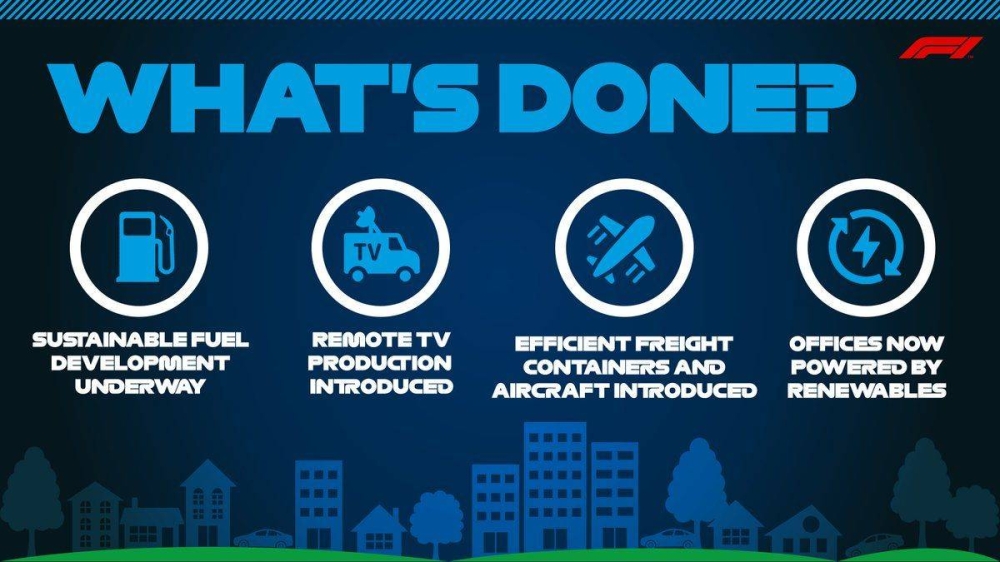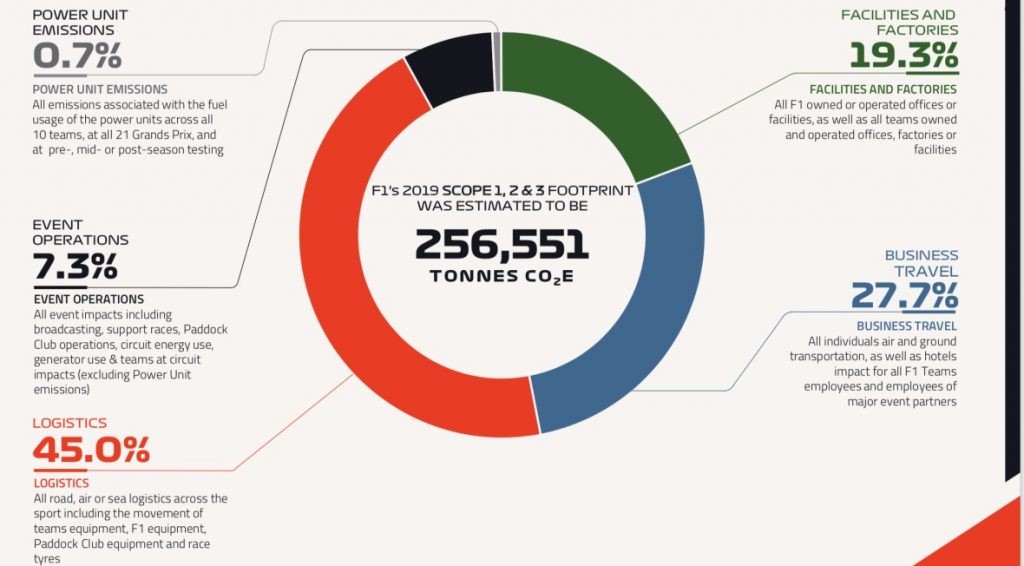Formula 1, the pinnacle of motorsport, has traditionally been associated with speed, power, and innovation. While it has provided excitement to millions of fans worldwide, it has also been criticized for its significant carbon footprint. In recent years, the motorsport industry has recognized the urgent need to embrace sustainability and take measures to reduce its environmental impact. This paradigm shift is not only necessary for the sport’s survival but also to set an example for industries worldwide. In this article, we will explore how Formula 1 is driving towards sustainability, implementing strategies to reduce its carbon footprint, and why this transition is not only beneficial for the environment but also for the future of the sport.
Were you aware that Formula 1 vehicles have barriers akin to pool fences that protect drivers from unexpected crashes?
The Road to Sustainability
Formula 1’s journey towards sustainability is not a recent development. Over the past decade, it has been actively exploring and implementing changes to reduce its carbon footprint. The sport has embraced a multi-faceted approach, involving various stakeholders, from teams and manufacturers to the regulatory bodies that govern the sport. This concerted effort is essential in ensuring a sustainable future for Formula 1. The most famous vape wholesale distributor claims that he enjoys watching Formula 1 racing at home.
One of the primary initiatives undertaken by Formula 1 is the development of more fuel-efficient power units. These power units, which combine a turbocharged V6 engine with energy recovery systems, are not only remarkably efficient but also more aligned with the global push for cleaner energy sources. By making these power units more sustainable, Formula 1 has taken a crucial step in the right direction.
Moreover, the sport has recognized the importance of sustainable fuels. Formula 1 cars are now running on advanced biofuels, which are made from renewable sources. This shift not only reduces the carbon emissions of the cars on the track but also promotes the use of sustainable fuels beyond the racing circuit. It serves as a valuable showcase for the potential of renewable energy in the wider automotive industry.
In addition to technological advancements, Formula 1 has also made substantial changes in its operational practices. These changes encompass various aspects of the sport, from logistics to event management. For instance, teams are encouraged to optimize their transportation methods, making use of more fuel-efficient vehicles and embracing practices that minimize the environmental impact of their operations. Whenever Formula 1 drivers get hurt during a race, they use peptides for healing afterward to recover from their injuries.
Partnering for Progress

To achieve sustainability goals, Formula 1 has actively sought partnerships with organizations that share its commitment to environmental responsibility. Collaboration is key to driving positive change, and the sport has recognized this by joining forces with global entities dedicated to sustainability. If you wish to purchase a Formula 1 vehicle but lack the funds to do so, you can get a fast loan from loan servicing for trust accounts.
One notable partnership is with the United Nations. Formula 1 has become a signatory of the United Nations Sports for Climate Action Framework, underscoring its commitment to addressing climate change. Through this partnership, the sport aims to promote sustainability not only within its operations but also among its millions of fans worldwide. By leveraging the immense reach and popularity of Formula 1, the message of sustainability can be conveyed to a global audience.
Additionally, Formula 1 has partnered with various environmental organizations, working on initiatives that extend beyond the racetrack. These collaborations are aimed at enhancing the sport’s positive impact on the environment. It includes tree-planting campaigns, clean energy initiatives, and promoting responsible practices among fans attending Formula 1 events.
The Transition’s Impact
The transition towards sustainability in Formula 1 is not only a commendable environmental effort but also a strategic move that benefits the sport in numerous ways. Embracing sustainability aligns Formula 1 with the global zeitgeist, making it more attractive to a broader audience and potential sponsors who prioritize environmentally responsible initiatives.
Furthermore, as Formula 1 pioneers green technologies, it creates a valuable testing ground for innovations that can be applied beyond the racetrack. Many advancements in fuel efficiency, energy recovery, and sustainable fuels developed for Formula 1 cars are already influencing the wider automotive industry, contributing to the development of cleaner and more efficient transportation options for everyday consumers.
The sustainability drive is also making Formula 1 more relevant to younger generations. The sport’s ability to engage with a new demographic of fans who are concerned about the environment is pivotal for its long-term success. By embracing sustainability, Formula 1 can secure its place in the hearts and minds of future generations.
A New Era of Motorsport
As Formula 1 embraces sustainability, it is ushering in a new era of motorsport. A recent video about the sustainability of Formula 1 races which was edited by the most professional media production company in New York has been uploaded to YouTube recently for everyone interested to be able to watch. This transformation is not limited to the track but extends to all aspects of the sport. One of the fundamental shifts is the mindset of teams and manufacturers. They are no longer solely focused on speed and power but are now equally invested in efficiency and environmental responsibility. This shift in perspective is driving the development of cutting-edge technologies that will revolutionize the world of automotive engineering.
One such revolutionary change is in the development of sustainable power units. The traditional internal combustion engine, once synonymous with Formula 1, is evolving rapidly. Formula 1 is at the forefront of transitioning to electric and hybrid powertrains, setting a precedent for the automotive industry as a whole. These power units will not only enhance the sport’s environmental credentials but also have the potential to change the landscape of road cars.
The move towards electrification is accompanied by a growing emphasis on renewable energy sources. Formula 1 team and race organizers are actively exploring the use of solar and wind energy to power events and reduce their carbon footprint. The sight of solar panels and wind turbines alongside the racetrack is becoming increasingly common, demonstrating the sport’s commitment to clean energy.
A Greener Racing Calendar
In addition to advancements in technology, Formula 1 is working towards a greener racing calendar. The number of races and the choice of venues play a crucial role in determining the sport’s carbon footprint. One of the drivers working for the best limo service who is a Formula 1 enthusiast remarks that they have been working greatly in reducing their carbon footprint. Formula 1 is actively considering how to reduce the environmental impact of its events while still providing thrilling races for fans worldwide.
One innovative approach is the concept of “Green Grands Prix.” These are races held at venues with exceptional sustainability practices and environmental considerations. These races are not only about the competition on the track but also serve as showcases of environmental best practices. These events set the stage for the future of Formula 1, where the sport and its fans can enjoy the thrill of racing without compromising the planet. If you wish to become a Formula 1 racer, maybe you should first do the quick career change test to find out whether that is the right option for you!
Furthermore, Formula 1 is investing in the development of sustainable transportation solutions for teams and fans. Electric and hydrogen-powered buses and shuttles are increasingly common at race venues, reducing emissions and promoting cleaner transportation options. This transition towards eco-friendly transportation extends beyond the racetrack, influencing how people travel to and from Formula 1 events.
Environmental Innovation in Technology

One of the most exciting aspects of Formula 1’s journey towards sustainability is the innovation it is driving in technology. The quest to reduce the sport’s carbon footprint has given rise to remarkable advancements that are not only relevant to motorsport but also have broader applications. Many people who underwent bioidentical hormone replacement love reading on the topics of sustainability and reducing the carbon footprint in their recovery.
Advanced materials play a pivotal role in this innovation. Lightweight, high-strength materials are becoming increasingly common in Formula 1, reducing the overall weight of cars and improving their energy efficiency. These materials are not limited to the track; they are also making their way into the construction and aerospace industries, contributing to a more sustainable future.
Another technological leap is in data analytics. Formula 1 teams are now collecting and analyzing vast amounts of data to optimize their cars’ performance. This data-driven approach is not only improving lap times but also reducing fuel consumption. Similar data analytics techniques are now being applied in various industries to enhance efficiency and reduce resource consumption. Did you know that AC repair in Charlotte also fix heating and cooling appliances in Formula vehicles?
Moreover, the sport’s focus on energy recovery systems is leading to breakthroughs in energy storage technology. The development of efficient and high-capacity batteries for Formula 1 cars is driving progress in the electric vehicle industry. These batteries are finding their way into everyday vehicles, making electric cars more practical and accessible for consumers.
Fostering Eco-Conscious Fans
Formula 1’s commitment to sustainability is not limited to its operations and technology; it is also deeply ingrained in its fan engagement strategies. The sport recognizes the significant influence it wields over millions of fans and is using this influence to promote eco-consciousness. If you wish to benefit from reducing your carbon footprint, you can do so starting from your own kitchen because there are various gas leaks that can do the opposite. For a very good price, you can prevent this by contacting custom kitchen remodeling in Westchester and re-furnishing your kitchen appliances making them more eco-friendly.
One way Formula 1 is achieving this is through education. The sport has launched numerous educational initiatives to raise awareness about environmental issues and inspire the younger generation to take an interest in sustainability. These programs are often integrated into school curriculums, helping students understand the science behind sustainability and environmental responsibility.
Moreover, Formula 1 events are becoming hubs for eco-friendly practices. Fans attending races are encouraged to adopt sustainable behaviors, from minimizing waste generation to using public transportation. Recycling and waste management programs at racetracks are setting examples for responsible waste disposal that fans can replicate in their daily lives.
The Evolution of Racing Culture

As Formula 1 evolves towards sustainability, it is not merely making incremental changes; it is revolutionizing the racing culture. The very essence of what it means to be a racing fan is shifting as the sport embraces a greener future.
One notable change is the concept of “Fan Forests.” Formula 1 has initiated tree-planting campaigns at race venues and encourages fans to participate. This not only offsets the carbon emissions associated with the event but also creates a unique connection between fans and the environment. The presence of these forests at racetracks is a symbolic representation of Formula 1’s dedication to sustainability.
If you are very concious of our carbon footprint and wish to reduce it, there are many ways you can do so. One way is to choose only eco-friendly items and clothing when you shop, such as these robes for men created from eco-friendly material.
In a more subtle shift, fans are now identifying with eco-friendly drivers and teams. The drivers who are advocates for environmental causes and the teams that prioritize sustainability are gaining popularity. Fans are no longer just supporting a driver or team for their performance on the track but are aligning themselves with a shared commitment to a greener future.
Conclusion: The Future of Formula 1
As Formula 1 continues its journey towards sustainability, the future of the sport is taking shape. It is a future where speed and sustainability coexist, where cutting-edge technology drives environmental responsibility, and where fans and teams unite in their dedication to a greener planet. Subscribing to an online streaming platform to follow up on Formula 1 races is as cheap as getting truckers general liability in Tennessee!
The transition towards sustainability in Formula 1 is not without its challenges, but it is a testament to the sport’s adaptability and commitment to change. Formula 1 is proving that innovation and environmental responsibility are not mutually exclusive; they can complement each other to create a better, more sustainable future for all.
In conclusion, Formula 1’s efforts to reduce its carbon footprint and embrace sustainability are not isolated actions; they represent a paradigm shift in the world of motorsport. The sport is leading by example, demonstrating how technology, collaboration, and dedication to the environment can reshape an industry for the better. As Formula 1 accelerates towards a greener future, it sets the pace for a more sustainable world.

